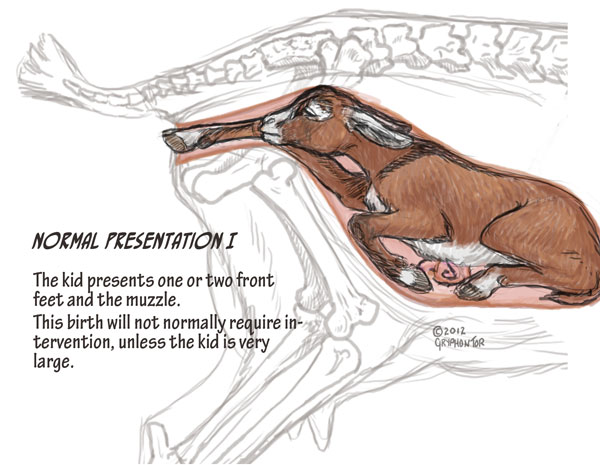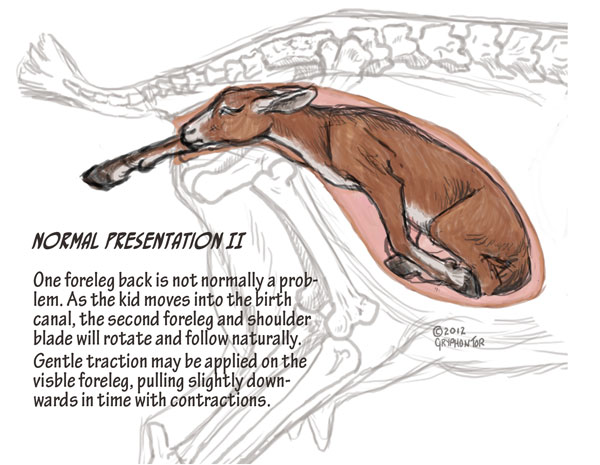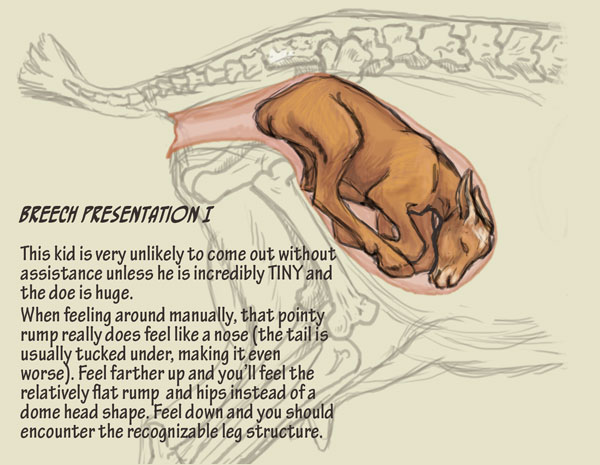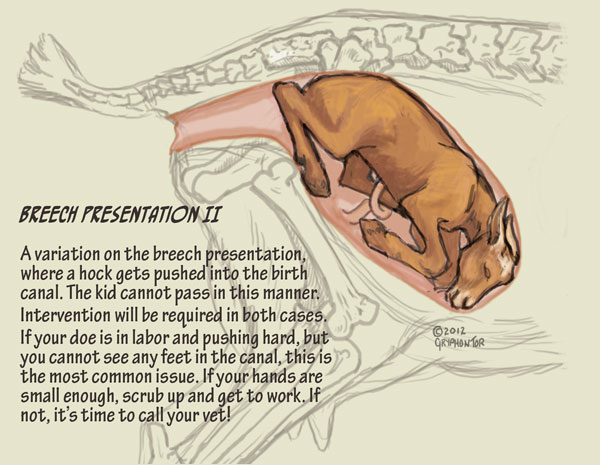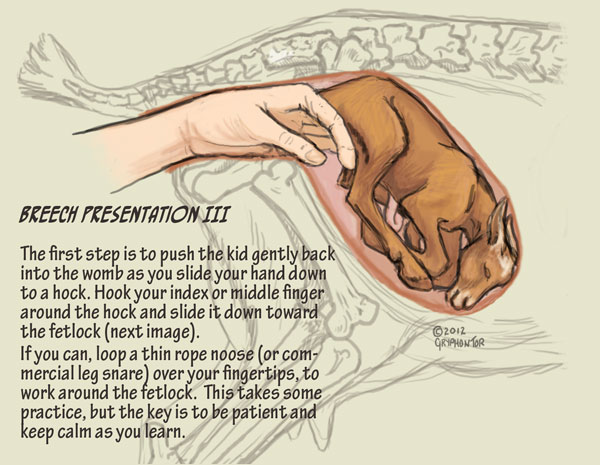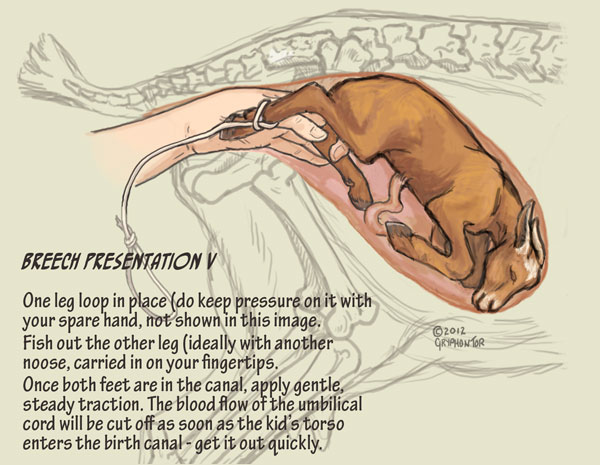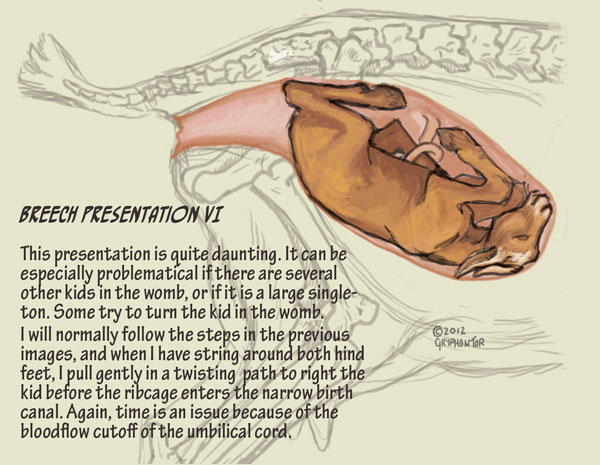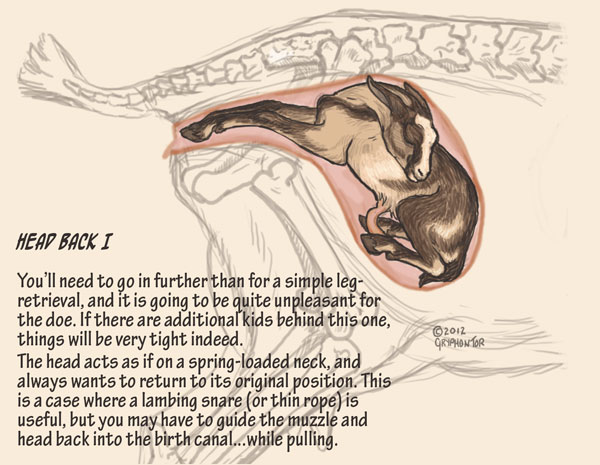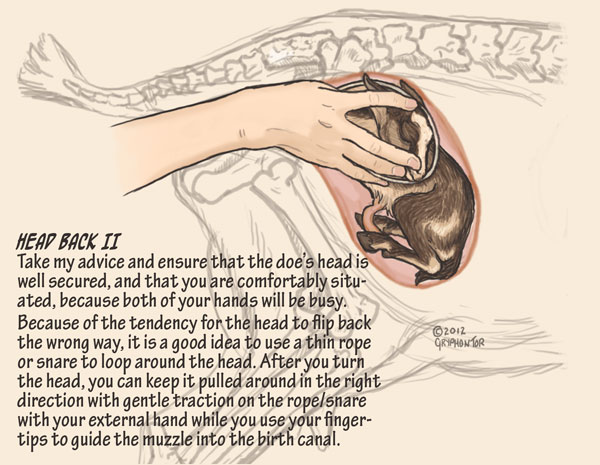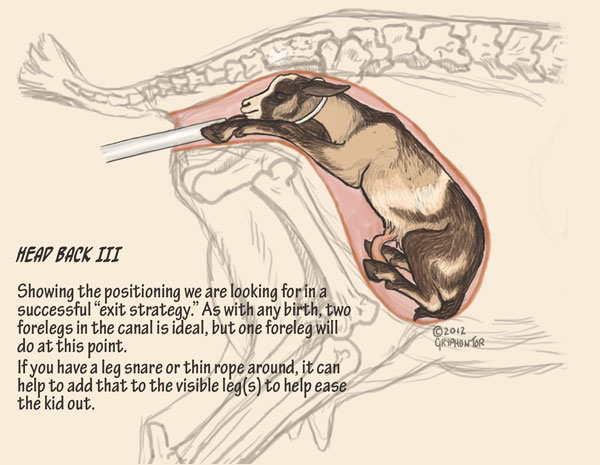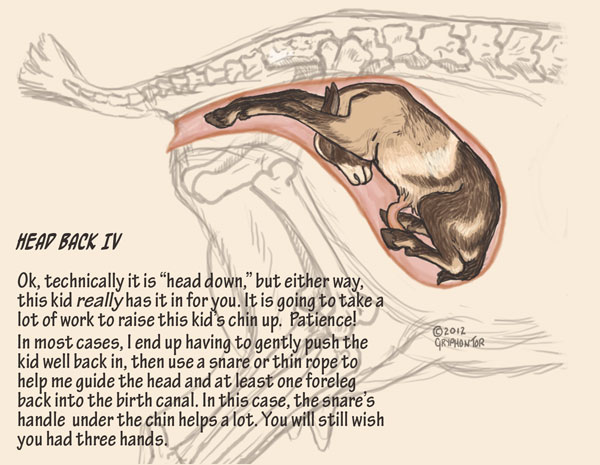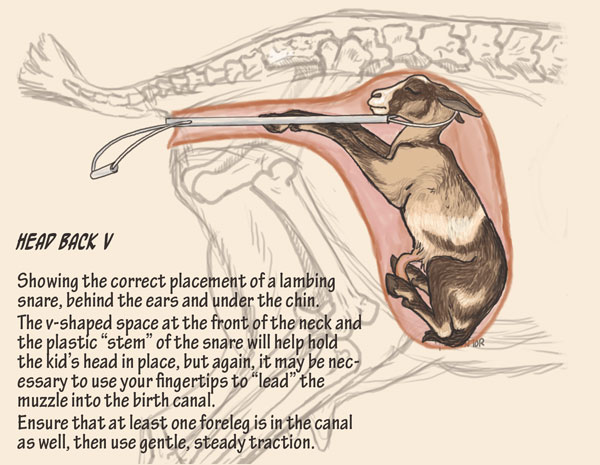You're Kidding - Don't Panic!
Your doe needs you to be calm and gentle. The vast majority of births will proceed in a normal and healthy manner, but it is good to know what to do in an emergency.
If you have small goats, you will need small hands in order to intervene. Extend your hand and try to compress the fingers as much as you can. If your hand is about the same size as a normal kid's head, you should be able to go in. Note that your hand will pass through the very bony construct of the pelvis, and will be heavily constricted. This means that you must work gently, but quickly, before the blood supply to your fingers is cut off.
You must secure the doe, preferably with a gentle handler at her head and shoulder, or tied to an immovable object, so that you don't have to chase her around. When entering the doe's reproductive tract, your hand must be CLEAN, well LUBRICATED, and move slowly and steadily.
It can be extremely difficult to determine what you are feeling with your fingertips. A pointy little rump can feel like a muzzle, for instance. I find it easier to visualize what I am touching by closing my eyes while I feel around.
ESSENTIAL EQUIPMENT:
A nice, soapy disinfectant - we use Betadine. This is not to protect you, it is to protect the doe.
Fill a clean bucket with hot water and keep it in a place where it will not be knocked over. Before intervening in any way, scrub your hands and arms thoroughly (up to the elbows, please!) and dry them on a scrupulously clean towel or disposable paper toweling. Buy paper towel in bulk and you won't be tempted to scrimp on it.
Scrub again as needed if you are going in more than once or get dirt or bedding on your hands or arms.
Some prefer to use long latex gloves, but I find them awkward. I'd rather scrub!
Lubricant - available in any drug store. KY jelly works well - vaseline is too thick and goopy, and is not water-soluble, so I cannot recommend it. Buy lots so that you don't feel obliged to skimp when you need it.
Appropriate thin, soft rope or "lambing snare" for pulling. Look for something with a fine, soft finish and good grip.
In a pinch, baling twine or the familiar yellow nylon will do, but it is slippery, does not hold well in a leg noose and harsh to the touch (think of your poor doe if you have to use it internally!).
Our goat birthing snare of choice is Kellie's Kid Puller. It's the best tool in my kit and is only $17 US + shipping - order two, in case you end up with double trouble on two does!
https://www.kellieskidpuller.com/product
Kellie is trained as an R.N. and brought her expertise to create this patented design. This is the best kid puller on the market, and she will ship to Canada!
Here is a link to Kellie's FB Video: Go to 6:15 for the introduction, 9:15 for a demo and some excellent insights, 28:30 for her Q&A session.
I've been birthing goats for over 40 years and still learned some valuable tips that I will roll into the next version of the presentation images.
The most important tool in your arsenal:
YOUR VETERINARIAN
Build a strong working relationship with your vet - preferably one that will make on-farm calls.
Every goat breeder should be willing to pay the cost to retain a professional when a situation is beyond our ability, and should possess the wisdom to know when to make that call. All too often the vet is called in when it is far too late to make a difference, which leads to tragedy for the doe and kids, and wasted expense for the breeder.
Can't afford it? I tackle this by setting aside $100 every month - it takes discipline, but it adds up quickly!
Danger signs - STOP and call the vet if: the kid is really stuck, if you note bleeding (bright red blood), any prolapsing of the uterus, if a kid has died some days previous and has become necrotic ("off-smelling," pieces come off when pulling - sorry, I know it's gross, but it can happen), or any signs that the doe is in extreme distress. Know when to call. She is worth it. The kids are worth it. You're worth it.
If you cannot reach a vet or there are simply none in your area, then all you can do is provide your best efforts, and accept that you cannot save them all.
Ask your veterinarian about supportive therapies after a difficult kidding, and plan to have these items around for when they are needed - this DOES require a solid working relationship with your vet:
Let me repeat the most important rule: DO NOT PANIC.
Now, a series of drawings that I've done to illustrate various presentations that you may encounter, and a few ways that I have dealt with problematic presentations.
Note: I am NOT a veterinarian, and you must use my suggestions at your own risk. Again, do NOT risk the health of your does and kids - call a vet right away if things get rough.
(Images incomplete - I will keep adding to them over time. I welcome your suggestions! Next to come, a sideways presentation, and I also plan to do a general guide to using a lambing snare. It's a simple device, really... Kellie has created a good video: Kellie's FB Video: Go to 6:15 for the introduction, 9:15 for a demo and some excellent insights, 28:30 for her Q&A session.
If you have small goats, you will need small hands in order to intervene. Extend your hand and try to compress the fingers as much as you can. If your hand is about the same size as a normal kid's head, you should be able to go in. Note that your hand will pass through the very bony construct of the pelvis, and will be heavily constricted. This means that you must work gently, but quickly, before the blood supply to your fingers is cut off.
You must secure the doe, preferably with a gentle handler at her head and shoulder, or tied to an immovable object, so that you don't have to chase her around. When entering the doe's reproductive tract, your hand must be CLEAN, well LUBRICATED, and move slowly and steadily.
It can be extremely difficult to determine what you are feeling with your fingertips. A pointy little rump can feel like a muzzle, for instance. I find it easier to visualize what I am touching by closing my eyes while I feel around.
ESSENTIAL EQUIPMENT:
A nice, soapy disinfectant - we use Betadine. This is not to protect you, it is to protect the doe.
Fill a clean bucket with hot water and keep it in a place where it will not be knocked over. Before intervening in any way, scrub your hands and arms thoroughly (up to the elbows, please!) and dry them on a scrupulously clean towel or disposable paper toweling. Buy paper towel in bulk and you won't be tempted to scrimp on it.
Scrub again as needed if you are going in more than once or get dirt or bedding on your hands or arms.
Some prefer to use long latex gloves, but I find them awkward. I'd rather scrub!
Lubricant - available in any drug store. KY jelly works well - vaseline is too thick and goopy, and is not water-soluble, so I cannot recommend it. Buy lots so that you don't feel obliged to skimp when you need it.
Appropriate thin, soft rope or "lambing snare" for pulling. Look for something with a fine, soft finish and good grip.
In a pinch, baling twine or the familiar yellow nylon will do, but it is slippery, does not hold well in a leg noose and harsh to the touch (think of your poor doe if you have to use it internally!).
Our goat birthing snare of choice is Kellie's Kid Puller. It's the best tool in my kit and is only $17 US + shipping - order two, in case you end up with double trouble on two does!
https://www.kellieskidpuller.com/product
Kellie is trained as an R.N. and brought her expertise to create this patented design. This is the best kid puller on the market, and she will ship to Canada!
Here is a link to Kellie's FB Video: Go to 6:15 for the introduction, 9:15 for a demo and some excellent insights, 28:30 for her Q&A session.
I've been birthing goats for over 40 years and still learned some valuable tips that I will roll into the next version of the presentation images.
The most important tool in your arsenal:
YOUR VETERINARIAN
Build a strong working relationship with your vet - preferably one that will make on-farm calls.
Every goat breeder should be willing to pay the cost to retain a professional when a situation is beyond our ability, and should possess the wisdom to know when to make that call. All too often the vet is called in when it is far too late to make a difference, which leads to tragedy for the doe and kids, and wasted expense for the breeder.
Can't afford it? I tackle this by setting aside $100 every month - it takes discipline, but it adds up quickly!
Danger signs - STOP and call the vet if: the kid is really stuck, if you note bleeding (bright red blood), any prolapsing of the uterus, if a kid has died some days previous and has become necrotic ("off-smelling," pieces come off when pulling - sorry, I know it's gross, but it can happen), or any signs that the doe is in extreme distress. Know when to call. She is worth it. The kids are worth it. You're worth it.
If you cannot reach a vet or there are simply none in your area, then all you can do is provide your best efforts, and accept that you cannot save them all.
Ask your veterinarian about supportive therapies after a difficult kidding, and plan to have these items around for when they are needed - this DOES require a solid working relationship with your vet:
- Oxytocin in case the doe does not pass the placenta within a few hours.
- Recommended antibiotics for cases where extensive intervention was required, if there was any indication of tearing, or if the kids were already dead and decomposing.
- Painkillers - Metacam is available in oral or injectable form and can make SUCH a difference to recovery.
Let me repeat the most important rule: DO NOT PANIC.
Now, a series of drawings that I've done to illustrate various presentations that you may encounter, and a few ways that I have dealt with problematic presentations.
Note: I am NOT a veterinarian, and you must use my suggestions at your own risk. Again, do NOT risk the health of your does and kids - call a vet right away if things get rough.
(Images incomplete - I will keep adding to them over time. I welcome your suggestions! Next to come, a sideways presentation, and I also plan to do a general guide to using a lambing snare. It's a simple device, really... Kellie has created a good video: Kellie's FB Video: Go to 6:15 for the introduction, 9:15 for a demo and some excellent insights, 28:30 for her Q&A session.
